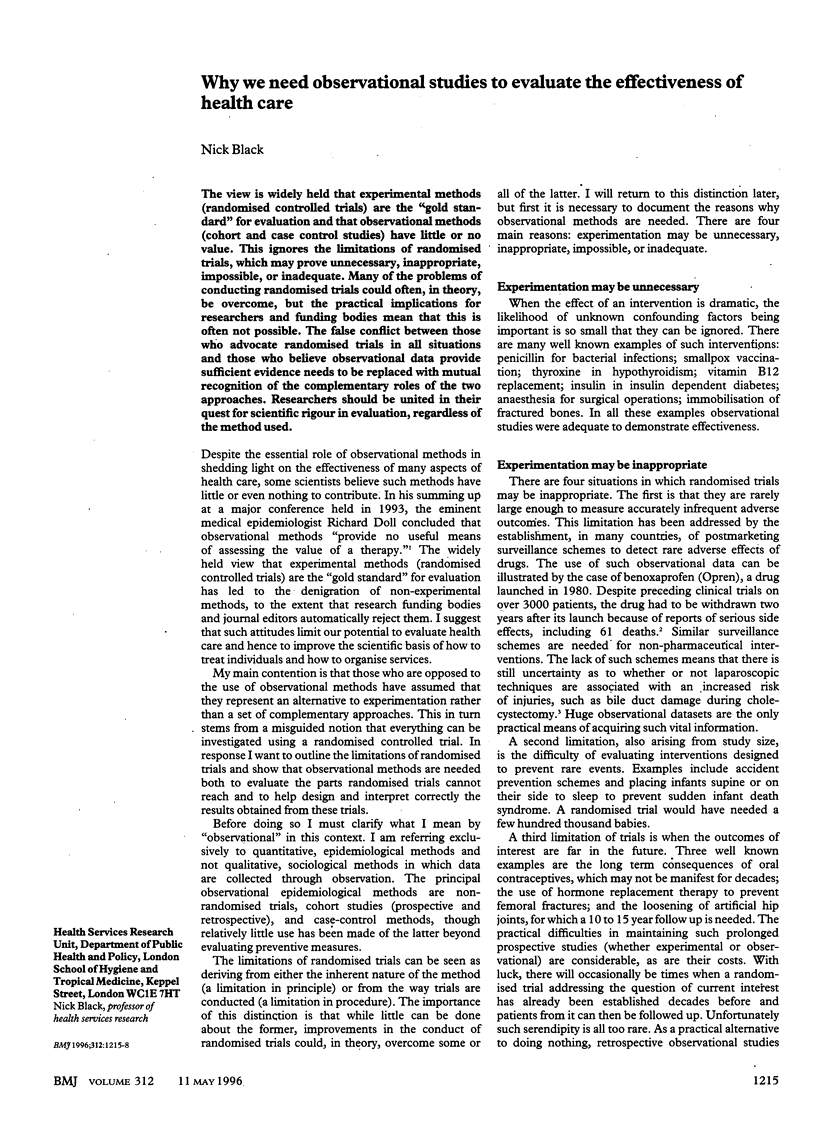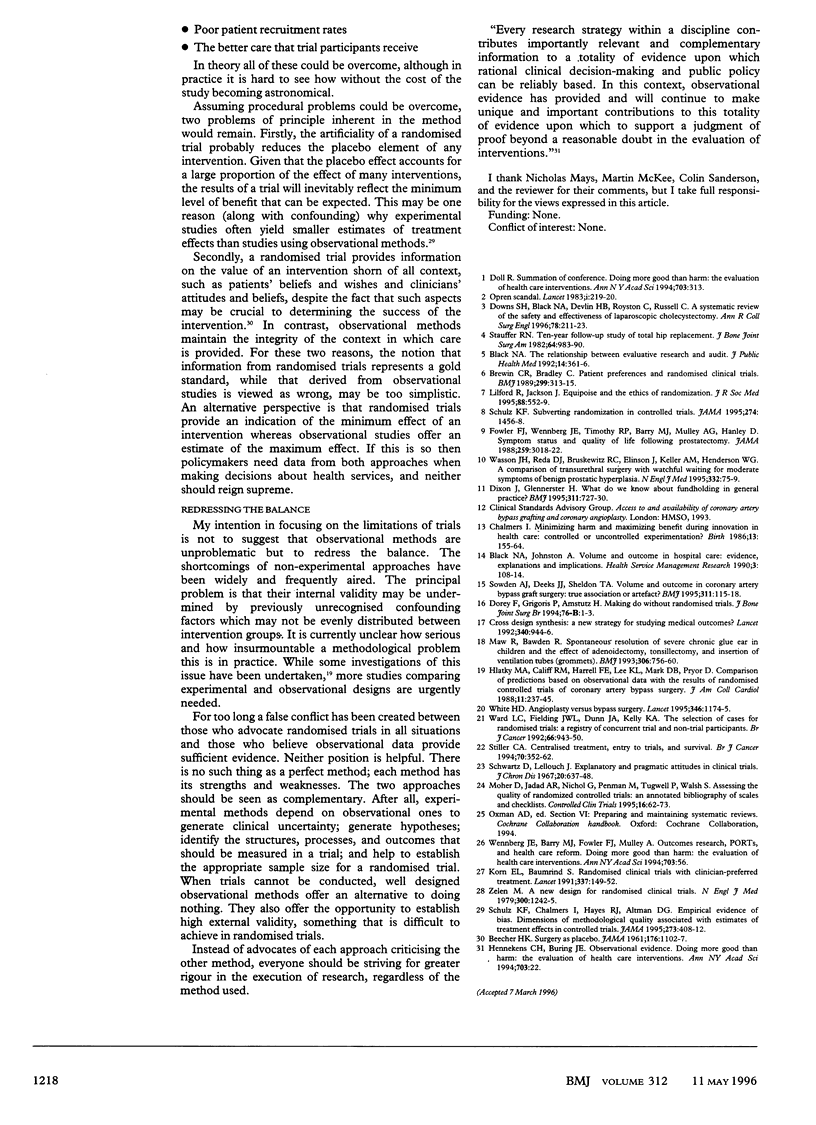Abstract
The view is widely held that experimental methods (randomised controlled trials) are the "gold standard" for evaluation and that observational methods (cohort and case control studies) have little or no value. This ignores the limitations of randomised trials, which may prove unnecessary, inappropriate, impossible, or inadequate. Many of the problems of conducting randomised trials could often, in theory, be overcome, but the practical implications for researchers and funding bodies mean that this is often not possible. The false conflict between those who advocate randomised trials in all situations and those who believe observational data provide sufficient evidence needs to be replaced with mutual recognition of the complementary roles of the two approaches. Researchers should be united in their quest for scientific rigour in evaluation, regardless of the method used.
Full text
PDF



Images in this article
Selected References
These references are in PubMed. This may not be the complete list of references from this article.
- Black N., Johnston A. Volume and outcome in hospital care: evidence, explanations and implications. Health Serv Manage Res. 1990 Jul;3(2):108–114. doi: 10.1177/095148489000300205. [DOI] [PubMed] [Google Scholar]
- Black N. The relationship between evaluative research and audit. J Public Health Med. 1992 Dec;14(4):361–366. doi: 10.1093/oxfordjournals.pubmed.a042773. [DOI] [PubMed] [Google Scholar]
- Brewin C. R., Bradley C. Patient preferences and randomised clinical trials. BMJ. 1989 Jul 29;299(6694):313–315. doi: 10.1136/bmj.299.6694.313. [DOI] [PMC free article] [PubMed] [Google Scholar]
- Chalmers I. Minimizing harm and maximizing benefit during innovation in health care: controlled or uncontrolled experimentation? Birth. 1986 Sep;13(3):155–164. doi: 10.1111/j.1523-536x.1986.tb01037.x. [DOI] [PubMed] [Google Scholar]
- Dixon J., Glennerster H. What do we known about fundholding in general practice? BMJ. 1995 Sep 16;311(7007):727–730. doi: 10.1136/bmj.311.7007.727. [DOI] [PMC free article] [PubMed] [Google Scholar]
- Fowler F. J., Jr, Wennberg J. E., Timothy R. P., Barry M. J., Mulley A. G., Jr, Hanley D. Symptom status and quality of life following prostatectomy. JAMA. 1988 May 27;259(20):3018–3022. [PubMed] [Google Scholar]
- Hlatky M. A., Califf R. M., Harrell F. E., Jr, Lee K. L., Mark D. B., Pryor D. B. Comparison of predictions based on observational data with the results of randomized controlled clinical trials of coronary artery bypass surgery. J Am Coll Cardiol. 1988 Feb;11(2):237–245. doi: 10.1016/0735-1097(88)90086-1. [DOI] [PubMed] [Google Scholar]
- Korn E. L., Baumrind S. Randomised clinical trials with clinician-preferred treatment. Lancet. 1991 Jan 19;337(8734):149–152. doi: 10.1016/0140-6736(91)90809-4. [DOI] [PubMed] [Google Scholar]
- Lilford R. J., Jackson J. Equipoise and the ethics of randomization. J R Soc Med. 1995 Oct;88(10):552–559. [PMC free article] [PubMed] [Google Scholar]
- Maw R., Bawden R. Spontaneous resolution of severe chronic glue ear in children and the effect of adenoidectomy, tonsillectomy, and insertion of ventilation tubes (grommets). BMJ. 1993 Mar 20;306(6880):756–760. doi: 10.1136/bmj.306.6880.756. [DOI] [PMC free article] [PubMed] [Google Scholar]
- Moher D., Jadad A. R., Nichol G., Penman M., Tugwell P., Walsh S. Assessing the quality of randomized controlled trials: an annotated bibliography of scales and checklists. Control Clin Trials. 1995 Feb;16(1):62–73. doi: 10.1016/0197-2456(94)00031-w. [DOI] [PubMed] [Google Scholar]
- Schulz K. F. Subverting randomization in controlled trials. JAMA. 1995 Nov 8;274(18):1456–1458. [PubMed] [Google Scholar]
- Schwartz D., Lellouch J. Explanatory and pragmatic attitudes in therapeutical trials. J Chronic Dis. 1967 Aug;20(8):637–648. doi: 10.1016/0021-9681(67)90041-0. [DOI] [PubMed] [Google Scholar]
- Stauffer R. N. Ten-year follow-up study of total hip replacement. J Bone Joint Surg Am. 1982 Sep;64(7):983–990. [PubMed] [Google Scholar]
- Stiller C. A. Centralised treatment, entry to trials and survival. Br J Cancer. 1994 Aug;70(2):352–362. doi: 10.1038/bjc.1994.306. [DOI] [PMC free article] [PubMed] [Google Scholar]
- Ward L. C., Fielding J. W., Dunn J. A., Kelly K. A. The selection of cases for randomised trials: a registry survey of concurrent trial and non-trial patients. The British Stomach Cancer Group. Br J Cancer. 1992 Nov;66(5):943–950. doi: 10.1038/bjc.1992.390. [DOI] [PMC free article] [PubMed] [Google Scholar]
- Zelen M. A new design for randomized clinical trials. N Engl J Med. 1979 May 31;300(22):1242–1245. doi: 10.1056/NEJM197905313002203. [DOI] [PubMed] [Google Scholar]



